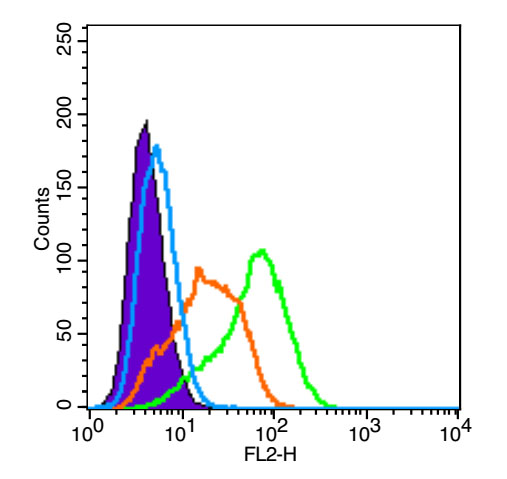
Rabbit Anti-TPOR antibody
C MPL; C-MPL; CMPL; CD110; CD 110; MPL; MPLV; Myeloproliferative leukemia protein; Myeloproliferative leukemia virus oncogene; Proto-oncogene c-Mpl; THCYT2; Thrombopoietin receptor; TPO R; TPO-R; TPOR; TPOR_HUMAN.
View History [Clear]
Details
Product Name TPOR Chinese Name 血小板生成素受体抗体 Alias C MPL; C-MPL; CMPL; CD110; CD 110; MPL; MPLV; Myeloproliferative leukemia protein; Myeloproliferative leukemia virus oncogene; Proto-oncogene c-Mpl; THCYT2; Thrombopoietin receptor; TPO R; TPO-R; TPOR; TPOR_HUMAN. literatures Research Area Tumour Cardiovascular Cell biology Apoptosis Immunogen Species Rabbit Clonality Polyclonal React Species Human, (predicted: Mouse, Rat, Dog, Sheep, ) Applications ELISA=1:5000-10000 IHC-P=1:100-500 IHC-F=1:100-500 Flow-Cyt=3μg/Test ICC=1:100-500 IF=1:100-500 (Paraffin sections need antigen repair)
not yet tested in other applications.
optimal dilutions/concentrations should be determined by the end user.Theoretical molecular weight 68kDa Cellular localization The cell membrane Form Liquid Concentration 1mg/ml immunogen KLH conjugated synthetic peptide derived from human TPOR: 401-500/635 <Extracellular> Lsotype IgG Purification affinity purified by Protein A Buffer Solution 0.01M TBS(pH7.4) with 1% BSA, 0.03% Proclin300 and 50% Glycerol. Storage Shipped at 4℃. Store at -20 °C for one year. Avoid repeated freeze/thaw cycles. Attention This product as supplied is intended for research use only, not for use in human, therapeutic or diagnostic applications. PubMed PubMed Product Detail In 1990 an oncogene, v-mpl, was identified from the murine myeloproliferative leukemia virus that was capable of immortalizing bone marrow hematopoietic cells from different lineages. In 1992 the human homologue, named, c-mpl, was cloned. Sequence data revealed that c-mpl encoded a protein that was homologous with members of the hematopoietic receptor superfamily. Presence of anti-sense oligodeoxynucleotides of c-mpl inhibited megakaryocyte colony formation. The ligand for c-mpl, thrombopoietin, was cloned in 1994. Thrombopoietin was shown to be the major regulator of megakaryocytopoiesis and platelet formation. The protein encoded by the c-mpl gene, CD110, is a 635 amino acid transmembrane domain, with two extracellular cytokine receptor domains and two intracellular cytokine receptor box motifs . TPO-R deficient mice were severely thrombocytopenic, emphasizing the important role of CD110 and thrombopoietin in megakaryocyte and platelet formation. Upon binding of thrombopoietin CD110 is dimerized and the JAK family of non-receptor tyrosine kinases, as well as the STAT family, the MAPK family, the adaptor protein Shc and the receptors themselves become tyrosine phosphorylated. [provided by RefSeq, Jul 2008]
Function:
Receptor for thrombopoietin. May represent a regulatory molecule specific for TPO-R-dependent immune responses.
Subunit:
Interacts with ATXN2L
Subcellular Location:
Membrane.
Tissue Specificity:
Expressed at a low level in a large number of cells of hematopoietic origin. Isoform 1 and isoform 2 are always found to be coexpressed.
Post-translational modifications:
Ubiquitination at Lys-553 and Lys-573 targets MPL for degradation by both the lysosomal and proteasomal pathways. The E3 ubiquitin-protein ligase CBL significantly contributes to this ubiquitination.
DISEASE:
Defects in MPL are a cause of congenital amegakaryocytic thrombocytopenia (CAMT) [MIM:604498]. CAMT is a disease characterized by isolated thrombocytopenia and megakaryocytopenia with no physical anomalies.
Similarity:
Belongs to the type I cytokine receptor family. Type 1 subfamily.
Contains 2 fibronectin type-III domains.
SWISS:
P40238
Gene ID:
4352
Database links:Entrez Gene: 4352 Human
Entrez Gene: 17480 Mouse
Omim: 159530 Human
SwissProt: P40238 Human
SwissProt: Q08351 Mouse
Unigene: 82906 Human
Unigene: 4864 Mouse
Unigene: 198731 Rat
Product Picture
Primary Antibody (green line): Rabbit Anti-TPOR antibody (SL10362R)
Dilution: 3μg /10^6 cells;
Isotype Control Antibody (orange line): Rabbit IgG .
Secondary Antibody (white blue line): Goat anti-rabbit IgG-PE
Dilution: 1μg /test.
Protocol
The cells were fixed with 4% paraformaldehyde for 10 min at room temperature. Cells incubated in 5%BSA to block non-specific protein-protein interactions for 30 min at room temperature. The cells were then stained with Primary Antibody for 30 min at room temperature. The secondary antibody used for 40 min at room temperature. Acquisition of 20,000 events was performed.
Bought notes(bought amounts latest0)
No one bought this product
User Comment(Total0User Comment Num)
- No comment




 +86 571 56623320
+86 571 56623320
 +86 18668110335
+86 18668110335

